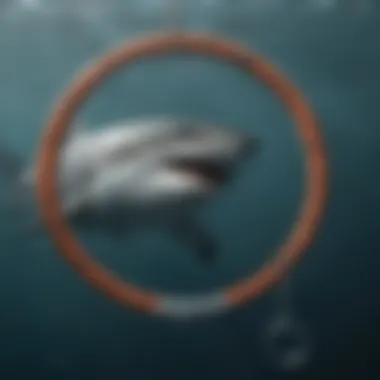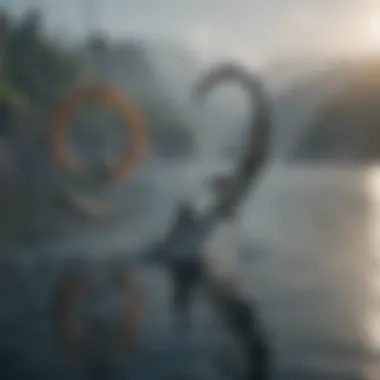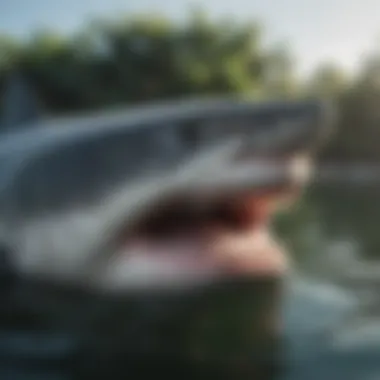Unlocking the Potential of Circle Hooks for Sustainable Shark Fishing Practices


Overview of the Topic
Circle hooks are vital tools in sustainable fishing practices, particularly when targeting sharks. These uniquely designed hooks offer a promising solution to address the pressing issue of overfishing and its detrimental impact on marine ecosystems. The utilization of circle hooks not only enhances conservation efforts but also plays a crucial role in minimizing bycatch, thus promoting responsible fishing practices.
Current Status and Challenges
The current state of shark populations worldwide presents a daunting conservation challenge. Overfishing and unsustainable fishing methods have led to a decline in shark numbers, endangering marine biodiversity. Traditional fishing hooks often result in high rates of bycatch, unintentionally capturing non-target species and further disrupting delicate aquatic ecosystems.
Sustainable Solutions
In response to these challenges, the adoption of circle hooks has emerged as a sustainable solution in shark fishing. Compared to conventional J-hooks, circle hooks are designed to reduce the likelihood of gut-hooking, a common issue in catch-and-release practices. By promoting safer and more ethical catch-and-release interactions, circle hooks contribute significantly to the conservation of shark populations and marine habitats.
Impact and Importance
The impact of employing circle hooks in shark fishing extends beyond immediate conservation benefits. By minimizing bycatch and supporting sustainable fishing practices, the use of circle hooks safeguards not only shark populations but also entire marine ecosystems. Conservationists, students, and environmentalists recognize the critical importance of integrating circle hooks into fishing practices to ensure the protection and preservation of our oceans for future generations.
Introduction
In the realm of sustainable fishing practices, the utilization of circle hooks for sharks holds significant importance. The choice to employ circle hooks over traditional J-hooks symbolizes a shift towards more eco-conscious fishing methods. Circle hooks are designed with a unique curvature that decreases the likelihood of a shark swallowing the hook, thus minimizing harm to the animal and making it easier to release unharmed back into the ocean.
Understanding Circle Hooks
The design of circle hooks
When delving into the design of circle hooks, their circular shape and inward-facing point stand out as distinctive features. These hooks are intentionally crafted to reduce the chances of causing internal injuries to fish, including sharks. The hook's design promotes a corner-of-the-mouth hookset, making it less likely for the shark to suffer severe injuries during the catching process.
Functionality in fishing practices


The functionality of circle hooks is paramount in sustainable fishing practices. Their unique design significantly enhances hooking efficiency while maintaining the structural integrity of the hook throughout the fishing process. Fishermen who use circle hooks report a higher success rate in catching target species like sharks while minimizing the unintentional capture of non-target marine life.
Significance of Sustainable Fishing
Impact on marine ecosystems
The impact of sustainable fishing using circle hooks extends to marine ecosystems. By reducing injuries and mortality rates in sharks, circle hooks play a pivotal role in preserving the delicate balance of marine life. Implementing circle hooks in fishing practices contributes to the overall health and stability of marine ecosystems, ensuring a sustainable future for oceanic biodiversity.
Importance of conservation
Circle hooks advocate for conservation by promoting the ethical treatment of marine life. Their design aligns with conservation efforts by prioritizing the well-being of sharks and other species. Conservationists recognize the significance of employing circle hooks to minimize harm to aquatic creatures, fostering a culture of responsible and environmentally conscious fishing.
Benefits of Circle Hooks for Sharks
Circle hooks play a crucial role in sustainable fishing practices, particularly in the context of shark fishing. These specialized hooks are designed to minimize harm to both target and non-target species, making them an essential tool for conservation-minded anglers. One of the key advantages of circle hooks is their ability to reduce bycatch, which refers to the unintended capture of non-target species. By minimizing accidental catches, circle hooks help preserve the delicate balance of marine ecosystems. Additionally, circle hooks are known for their enhanced hooking efficiency, ensuring a higher rate of successful catches while also promoting ethical fishing practices.
Reduced Bycatch
- Minimizing unintended catches: A standout feature of circle hooks is their effectiveness in reducing bycatch, thereby decreasing the impact of fishing activities on non-target species. This minimization of unintended catches is a critical aspect of sustainable fishing, as it reflects a conscious effort to protect marine biodiversity. The unique design of circle hooks, with their inward-bending point, helps in hooking the target species while reducing the chances of engaging non-target organisms.
- Preserving non-target species: Preserving non-target species is paramount in sustainable fishing, and circle hooks excel in this aspect. Their ability to hold the intended catch securely without causing extensive damage to non-target species is a key benefit. By minimizing harm to unintended catches, circle hooks help ensure the continuity of marine ecosystems and contribute to long-term conservation efforts.
Enhanced Hooking Efficiency
- Improving hooking success: Circle hooks are renowned for their superior hooking success compared to traditional J-hooks. The design of circle hooks allows for a more natural bait presentation, increasing the likelihood of a successful hook set. This improved hooking efficiency not only benefits anglers by enhancing their catch rates but also promotes sustainable fishing practices by reducing the chances of injury to sharks and other marine species.
- Ensuring hook stability: Another notable advantage of circle hooks is their superior hook stability during fishing operations. Once a fish takes the bait and starts moving away, the circular motion of the hook ensures a more secure hook set. This stability is vital for reducing the risk of fish escaping or suffering from deep hook injuries, emphasizing the importance of using circle hooks for sustainable and responsible fishing practices.
Impact on Shark Populations
The impact on shark populations is a pivotal aspect of sustainable fishing practices, particularly concerning the utilization of circle hooks. By employing circle hooks, we can significantly contribute to the preservation of shark populations in marine ecosystems. The conservation benefits derived from using circle hooks extend beyond minimizing bycatch to directly influencing the sustainability of shark species. This method aids in ensuring the long-term viability of shark populations by reducing the mortality rates associated with traditional fishing hooks.
Conservation Benefits


Contribution to shark protection
The contribution of circle hooks to shark protection is profound. These hooks are designed to increase the chance of a safe catch-and-release method, thereby reducing fatal injuries to sharks. The distinct circular shape of these hooks makes it more likely for the hook to lodge in the corner of the shark's mouth, minimizing physical harm. This characteristic makes circle hooks a popular choice among conservationists and sustainable fishing advocates. Despite some challenges in hooking efficiency, the overall benefits of protecting shark populations outweigh any minor limitations.
Promoting sustainable fishing
The promotion of sustainable fishing practices through the use of circle hooks is paramount in marine conservation efforts. By adopting circle hooks, fishermen adhere to regulations that mandate the conservation of shark species. This method promotes responsible fishing behaviors and aligns with the goals of sustainable resource management. The unique feature of circle hooks lies in their ability to reduce post-release mortality rates, ultimately contributing to the sustainability of shark populations. Although transitioning to circle hooks may require adjustments in fishing techniques, the long-term advantages of promoting sustainable fishing far outweigh any initial challenges.
Population Sustainability
Maintaining healthy shark populations
Maintaining healthy shark populations is critical for the ecological balance of marine environments. Through the use of circle hooks, fishermen can actively participate in preserving the health of shark species. Circle hooks reduce the risk of deep hooking, which can lead to severe injuries and decreased survival rates among sharks. Consequently, the practice of maintaining healthy shark populations through circle hooks promotes biodiversity and ecosystem stability. The unique feature of reducing post-release mortality rates showcases the efficiency of this method in contributing to sustainable fishing practices.
Long-term species preservation
Long-term species preservation is a key objective in the conservation of shark populations. Circle hooks play a significant role in ensuring the preservation of shark species for future generations. By reducing catch-and-release mortalities, circle hooks aid in the long-term sustainability of shark populations. This approach aligns with conservation goals aimed at protecting endangered shark species and maintaining biodiversity in marine ecosystems. The unique feature of circle hooks in preserving species integrity underscores their importance in sustainable fishing practices and underscores the critical role they play in marine conservation efforts.
Alignment with Conservation Efforts
Explaining the importance of the topic 'Alignment with Conservation Efforts' in this article involves delving into specific elements, benefits, and considerations regarding this crucial aspect. In the realm of sustainable fishing practices, ensuring that fishing methods align with conservation goals is paramount. By utilizing circle hooks for shark fishing, fishermen can significantly contribute to marine ecosystem preservation and the conservation of shark populations globally. The strategic use of circle hooks minimizes the impact on non-target species and aids in promoting sustainable fishing practices.
Promoting Responsible Fishing
Adhering to Fishing Regulations
Discussing the adherence to fishing regulations entails highlighting the critical role it plays in upholding ethical fishing practices. Compliance with regulations not only ensures the legality of fishing operations but also safeguards marine environments and vulnerable aquatic species. The key characteristic of adhering to fishing regulations lies in its ability to prevent overfishing and promote resource sustainability. This adherence is a popular choice for this article due to its substantial impact on marine conservation efforts. The unique feature of adherence to fishing regulations is the establishment of clear guidelines that help maintain fish stocks while preventing the exploitation of marine resources.
Supporting Sustainable Practices


Exploring the support for sustainable practices emphasizes the advocacy for environmentally conscious fishing methods. By supporting sustainability in fishing activities, individuals can actively participate in the protection of marine ecosystems and the preservation of biodiversity. The key characteristic of supporting sustainable practices is its contribution to long-term environmental stability and the promotion of responsible consumption of marine resources. This choice aligns effortlessly with the core ethos of this article, focusing on the integration of eco-friendly approaches within fishing industries. The unique feature of supporting sustainable practices lies in its emphasis on ecosystem health, prioritizing the longevity of natural resources over short-term gains.
Encouraging Eco-Friendly Approaches
Reducing Environmental Impact
Addressing the reduction of environmental impact underscores the importance of minimizing ecological harm caused by fishing operations. Implementing strategies to reduce environmental impact involves utilizing sustainable gear, such as circle hooks, to mitigate negative consequences on marine habitats. The key characteristic of reducing environmental impact is its potential to lessen pollution, habitat destruction, and overall ecosystem degradation. This approach is pivotal for this article as it showcases how minor adjustments in fishing practices can lead to substantial conservation outcomes. The unique feature of reducing environmental impact lies in its ability to improve the overall health of aquatic ecosystems while promoting a harmonious relationship between fishing activities and nature.
Preserving Marine Biodiversity
Delving into the preservation of marine biodiversity emphasizes the importance of maintaining species richness and ecosystem balance within marine environments. Preserving marine biodiversity involves implementing measures to conserve and protect various aquatic species from extinction or population declines. The key characteristic of preserving marine biodiversity is its role in safeguarding the genetic diversity and ecological integrity of marine ecosystems. This aspect resonates deeply with the theme of this article by highlighting the indispensable value of marine biodiversity in sustaining healthy aquatic habitats. The unique feature of preserving marine biodiversity lies in its holistic approach to biodiversity conservation, considering the interconnectedness of marine species and their habitats for long-term sustainability.
Conclusion
Circle hooks play a crucial role in sustainable shark fishing practices by reducing bycatch and promoting responsible fishing. The adequate utilization of circle hooks can significantly contribute to the conservation of shark populations and marine ecosystems. Their design and functionality enhance hooking efficiency while minimizing unintended catches, making them an ideal choice for environmentally conscious fishers.
Summary of Circle Hooks for Shark Fishing
Efficiency in sustainable fishing
The efficiency of circle hooks in sustainable fishing lies in their ability to minimize harm to non-target species and preserve marine biodiversity. Their unique feature of ensuring hook stability results in higher success rates in catching target species, reducing the negative impact on marine ecosystems. Although their design may take some adjustment for traditional fishers, the benefits of using circle hooks outweigh any initial challenges, making them a popular and ethical choice for shark fishing.
Impact on marine conservation
Circle hooks contribute significantly to marine conservation efforts by decreasing bycatch and lowering the ecological footprint of fishing activities. Their key characteristic of preserving non-target species helps maintain a balanced marine ecosystem, ultimately promoting sustainable fishing practices. While there may be minor disadvantages, such as a learning curve for fishers transitioning from other hook types, the positive impact of circle hooks on marine conservation far outweighs any drawbacks.
Future Implications
Continued adoption of circle hooks
The continued adoption of circle hooks is essential for the long-term sustainability of shark populations and marine environments. Their specific feature of reducing unintended catches showcases their importance in minimizing the adverse effects of traditional fishing methods. By actively choosing to use circle hooks, fishers support conservation efforts and contribute to the preservation of vulnerable marine species.
Advancing ethical fishing practices
Advancing ethical fishing practices through the use of circle hooks demonstrates a commitment to responsible environmental stewardship. The key characteristic of circle hooks promoting selective and sustainable fishing aligns with ethical standards and regulatory requirements. While some fishers may face challenges in transitioning to circle hooks due to their unfamiliarity, the ethical advantages of these hooks greatly outweigh any temporary inconveniences.



